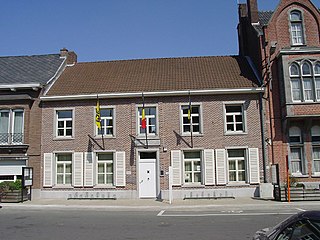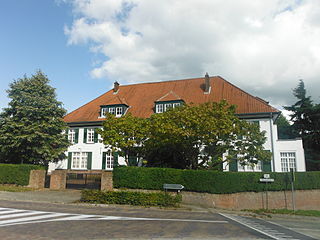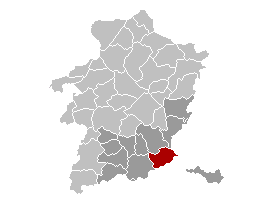
Hamsters are rodents belonging to the subfamily Cricetinae, which contains 19 species classified in seven genera. They have become established as popular small pets. The best-known species of hamster is the golden or Syrian hamster, which is the type most commonly kept as pets. Other hamster species commonly kept as pets are the three species of dwarf hamster, Campbell's dwarf hamster, the winter white dwarf hamster and the Roborovski hamster.

Torhout is a municipality located in the Belgian province of West Flanders. The municipality comprises the city of Torhout proper, the villages of Wijnendale and Sint-Henricus, and the hamlet of De Driekoningen. On January 1, 2012, Torhout had a total population of 20,149. The total area is 45.23 km² which gives a population density of 445 inhabitants per km².

Deerlijk is a municipality located in the Belgian province of West Flanders. The municipality only comprises the town of Deerlijk proper. On January 1, 2006, Deerlijk had a total population of 11,310. The total area is 16.82 km² which gives a population density of 673 inhabitants per km².

Oostrozebeke is a municipality located in the Belgian province of West Flanders. The municipality comprises only the town of Oostrozebeke proper. On January 1, 2018 Oostrozebeke had a total population of 7,849. The total area is 16.62 km² which gives a population density of 472 inhabitants per km².

Alveringem is a municipality located in the Belgian province of West Flanders. The municipality comprises the towns of Alveringem proper, Beveren-aan-de-IJzer, Gijverinkhove, Hoogstade, Izenberge, Leisele, Oeren, Sint-Rijkers and Stavele. On January 1, 2006, Alveringem had a total population of 4,887. The total area is 80.01 km² which gives a population density of 61 inhabitants per km². The mayor of Alveringem is Gerard Liefooghe (Gemeentebelangen) since 2006.

Nieuwpoort is a municipality located in Flanders, one of the three regions of Belgium, and in the Flemish province of West Flanders. The municipality comprises the city of Nieuwpoort proper and the towns of Ramskapelle and Sint-Joris. On 1 January 2008, Nieuwpoort had a total population of 11,062. The total area is 31.00 km² which gives a population density of 350 inhabitants per km². The current mayor of Nieuwpoort is Geert Vanden Broucke (CD&V)

Beersel is a municipality located in the Belgian province of Flemish Brabant. The municipality comprises the towns of Alsemberg, Beersel proper, Dworp, Huizingen and Lot. On 1 January 2018 Beersel had a total population of 25,069. The total area is 30.01 km² which gives a population density of 835 inhabitants per km². It is close to Brussels; Beersel is approximately 12 km southwest of the center of the city.

Drogenbos is a municipality located in the Belgian province of Flemish Brabant. The municipality only comprises the town of Drogenbos proper. On January 1, 2018, Drogenbos had a total population of 5,599. The total area is 2.49 km² which gives a population density of 2,248 inhabitants per km².

Hoeilaart is a municipality in the province of Flemish Brabant, Belgium. The name Hoeilaart is of Gallic-Celtic origin, coming from "Ho-Lar," meaning a high clearing in the woods. Residents are called Hoeilanders or Doenders. The municipality only comprises the town of Hoeilaart proper. On January 1, 2019, Hoeilaart had a total population of 11,325. The total area is 20.43 km² which gives a population density of 493 inhabitants per km². Hoeilaart also sometimes called "The Glass Village" because of the greenhouse grape cultivation that once took place.

Opwijk is a municipality located in the Belgian province of Flemish Brabant. The municipality comprises the towns of Mazenzele and Opwijk proper. On January 1, 2012, Opwijk had a total population of 13,990. The total area is 19.69 km² which gives a population density of 690 inhabitants per km².

Roosdaal is a municipality located in the Belgian province of Flemish Brabant. The municipality comprises the towns of Borchtlombeek, Onze-Lieve-Vrouw-Lombeek, Pamel and Strijtem. It is also situated in the Pajottenland.

Ternat is a municipality located in the Belgian province of Flemish Brabant. The municipality comprises the villages of Sint-Katherina-Lombeek, Ternat proper and Wambeek. It is also situated in the Pajottenland. On January 1, 2018 Ternat had a total population of 15.481. The total area is 24.48 km² which gives a population density of 597 inhabitants per km².

Bierbeek is a municipality located in the Belgian province of Flemish Brabant. The municipality comprises the towns of Bierbeek proper, Korbeek-Lo, Lovenjoel and Opvelp. On January 1, 2006, Bierbeek had a total population of 9,147. The total area is 39.73 km² which gives a population density of 230 inhabitants per km².

Boutersem is a municipality located in the Belgian province of Flemish Brabant. The municipality comprises the towns of Boutersem proper, Kerkom, Neervelp, Roosbeek, Vertrijk and Willebringen. On January 1, 2006, Boutersem had a total population of 7,532. The total area is 30.75 km² which gives a population density of 245 inhabitants per km².

Herent is a municipality located in the Belgian province of Flemish Brabant. The municipality comprises the villages and former municipalities of Herent proper, Veltem-Beisem and Winksele. On January 1, 2016, Herent had a total population of 21,213. The total area is 32.73 km² resulting in a population density of 648 inhabitants per km². The current mayor is Astrid Pollers.

Holsbeek is a municipality located in the Belgian province of Flemish Brabant. The municipality comprises the towns of Holsbeek proper, Kortrijk-Dutsel, Nieuwrode and Sint-Pieters-Rode. On January 1, 2006, Holsbeek had a total population of 9,205. The total area is 38.50 km2 which gives a population density of 239 inhabitants per km2.

Kortenberg is a Belgian municipality located in the province of Flemish Brabant, about halfway between the cities of Brussels and Leuven. The municipality comprises the subdivisions or deelgemeenten of Erps-Kwerps, Everberg, Kortenberg proper and Meerbeek. On 1 January 2013 Kortenberg had a total population of 19,393. The total area is 34.52 km² which gives a population density of about 562 inhabitants per km². In the southern part of Everberg there is also a hamlet called Vrebos, while between Erps-Kwerps and Meerbeek there is another hamlet called Schoonaarde, which can be found in the proximity of the train station of Erps-Kwerps.

Lubbeek is a municipality located in the Belgian province of Flemish Brabant. The municipality comprises the towns of Binkom, Linden, Lubbeek proper and Pellenberg. On January 1, 2006, Lubbeek had a total population of 13,660. The total area is 46.13 km² which gives a population density of 296 inhabitants per km².

Riemst is a small town and a municipality in the Belgian province of Limburg. Riemst is in the Flemish speaking area of Belgium.

The European hamster, also known as the Eurasian hamster, black-bellied hamster or common hamster, is the only species of hamster in the genus Cricetus. It is native to grassland and similar habitats in a large part of Eurasia, extending from Belgium to the Altai Mountains and Yenisey River in Russia. Historically, it was considered a farmland pest and had been trapped for its fur. Its population has declined drastically in recent years and is now considered critically endangered. The main threats to the species are thought to be intensive agriculture, habitat destruction, and persecution by farmers.

![]() listen )) is a municipality located in the Belgian province of Flemish Brabant. The municipality comprises the towns of Bertem proper, Korbeek-Dijle and Leefdaal. On January 1, 2006, Bertem had a total population of 9,215. The total area is 29.75 km² which gives a population density of 310 inhabitants per km².
listen )) is a municipality located in the Belgian province of Flemish Brabant. The municipality comprises the towns of Bertem proper, Korbeek-Dijle and Leefdaal. On January 1, 2006, Bertem had a total population of 9,215. The total area is 29.75 km² which gives a population density of 310 inhabitants per km².























